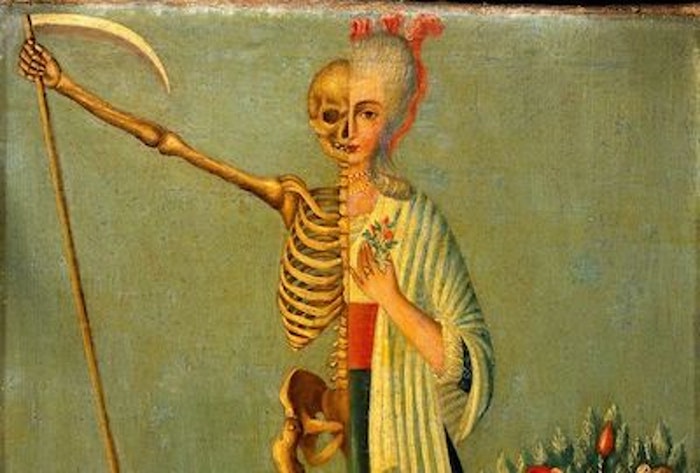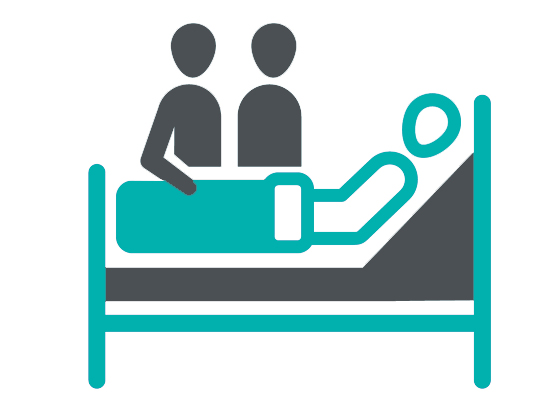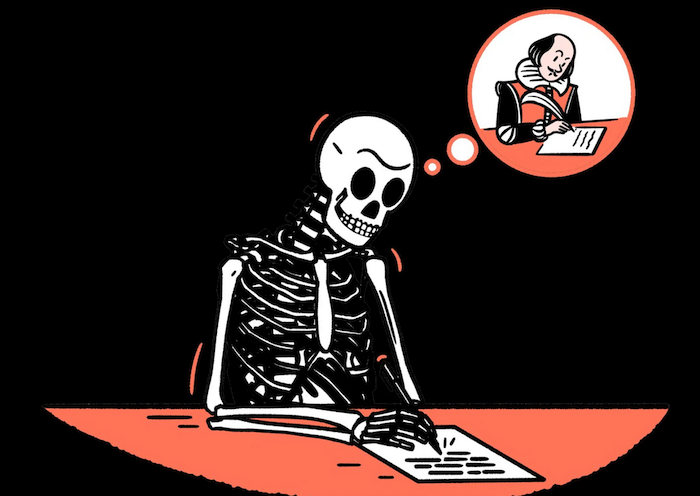She arranges everything, from finding long lost families to organising organ donation
She’s only 26 but Claire Wretham is employed by a Welsh hospice to help people face death.
She is the youngest person in any of Marie Curie’s nine hospices nationwide in the role.
Watching her own grandmother have “a beautiful death” inspired her to help others do the same.
“We all deserve a good death that celebrates life. I am helping people feel at peace,” she said.
As full time spiritual care co-ordinator at Marie Curie Hospice, Cardiff and the Vale , Claire answers any questions patients and their families have about life’s greatest mystery.

“My grandmother died at home, a really beautiful death with all her family around her. We were able to facilitate for her the perfect death.
In an increasingly secular and diverse society her role at Marie Curie has replaced the traditional one of chaplain, although Claire still uses that term when first meeting patients.
“I introduce myself as chaplain because it really is a modern interpretation of that,” she explained.
“My age is mostly irrelevant. People often comment on the fact I am young but I don’t think it hinders my role.
“People my age group see the world differently and approach things in a different way.
“Part of my role is asking people “what makes you you, how would you describe yourself and how do you find peace?
“As younger people we often have lots of spaces and experiences to express ourselves, but some older people don’t feel the same freedom to express themselves, so I ask “who are you, what makes you you and what makes you comfortable and at peace?.”
A practising Christian, Claire was appointed to the job two years ago and is an “allied health professional”, not a medic, although she knows and can explain what may happen during dying and immediately after.
Her role as spiritual adviser was created in response to research that Marie Curie did in 2015 investigating how to improve access to palliative care for people with dementia, learning disabilities and people with different or no religious beliefs.
Sarah Lloyd-Davies, hospice manager at Marie Curie Hospice, Cardiff and the Vale, explained: Hospice care and chaplaincy services have long been rooted in the Christian tradition, as both developed at a time when Christianity was the majority religion in the UK.
“As the country has grown more diverse there has also been a trend in growing numbers of people identifying as nonreligious.
“The hiring of a spiritual care coordinator to replace the traditional chaplain role at the Marie Curie Hospice Cardiff and Vale reflects the feedback from our local community, which recognises that one person and one approach cannot meet everyone’s spiritual needs.
“In order to make sure our services are truly inclusive and person-centred, we need to focus on connecting with belief-based communities and exploring new ways of providing spiritual care so we can ensure people feel supported in the best way for them at the end of their life.
Whatever background people come from death and dying are still taboo subjects which Claire must help them face.
“A lot of my job is myth busting and explaining to people how it works at the hospice and what they can expect as they come to the end of their life,” the 26 year-old said.
“Questions I would normally ask are whether they have any spiritual or religious needs and whether they have a faith or anything that’s a source of comfort.
“If they are religious I will discuss that with them – for instance if they are Catholic and want the last rites I liaise with their priest, if they are Muslim and want their bed facing Mecca and halal meals my job is to arrange that and liaise with nursing staff about it.”
There is “no formula or prescription” for talking about death so Claire begins with a few questions.
“It’s about asking questions to get people to explore death or go away and think about it.
“The sort of questions I’ll ask are things like – have you got any unfinished business or anything you want to tie up? That can be relationships, writing a will, funeral planning, making amends with estranged family members , and how we can help with that, if we can.”
When patients tell her they are scared of dying she tries to remove some of the mystery around it to reassure.
“If someone is scared of dying a big part of it, from my point of view, is explaining what will happen when they die.
“There are lots of misconceptions about pain relief. They want to know what it will feel like. I explain that they will probably just fall asleep more.
“I explore with them what they think that will be like. There is nothing you can say really, ultimately it’s something people form their own ideas about.
“I may also ask people what they want their legacy to be. Some people think there is nothing after you are dead so I’d ask them how they want to be remembered.”
But she doesn’t push it if people don’t want to talk.
“We live in a culture where it’s normal to talk about things but the idea of a chaplaincy and spiritual support is so alien to some people that they say no, they don’t want to talk to me.”
As she doesn’t have all the answers Claire tries to keep things practical when explaining what happens after death in a hospice.
“I know what a dead body looks like, where you go after death and what the crematorium looks like.
“My main technique is to remove any confusion. I do ask people if they are frightened and how I can help them not feel afraid.
“Most of the time people are worried about “what’s happening next and what about the pain?”
“I think death is so difficult to talk about because we don’t see death often. The majority of deaths happen in hospital. People don’t know what death looks like.
“For us in a hospice a huge part of our role is pulling the curtain on that. Lots of people come in asking really big questions and having misconceptions.”
These include controversy and suspicion surrounding syringe drives to administer pain relief and the mistaken beliefs about how they are used.
“People are horrified by the syringe driver. It’s in a locked box and nurses replenish pain killers. It is controlled pain relief. Some people think it is a death sentence, but it’s not. Sometimes people have a syringe driver for pain relief and then have it removed.”
“On the other hand some people say “can I have the drugs now?”. That’s not legal and not what hospices are about.”
“When we talk to people here about donation it’s usually only corneas because they can’t donate anything else. Some people say “you can take anything but not my eyes, but I have watched eyeball removal and it is really amazing because one cornea can be used to help eight people.”
It is Claire’s job to arrange any donations. She recalled one case when she arranged for a motorbike to collect the brain of a patient with motor neurone disease who had requested it be donated to medical science – something that had to be arranged within 72 hours.
“I spent all day organising brain removal and that afternoon someone came down from London on a motorbike and took it back for donation to medical science.”
Although her job does involve these practical matters it is also a matter of listening to people at what can be the hardest time of their lives.
“My job is varied Once a man came in and said his father had died here 28 years ago. He said he had never visited Wales and now lives in Canada but had flown into Cardiff to see where his father died.
“I showed him around the hospice and talked to him about his grief and about Penarth. He was very tearful, he had flown all the way from Canada to see where his dad died, but he was able to resolve his grief.”
Surrounded by grief and death on a daily basis Claire says it is not morbid but a privilege to help people.
“Death happens to everyone. It’s coming to all of us. We should look to normalise it.”
Complete Article ↪HERE↩!
To Die Is Different From What Anyone Supposed
Art, philosophy and mortality.
At an overlooked moment in his Essays, Michel de Montaigne writes that “life itself is neither a good nor an evil; life is where good or evil find a place, depending on how you make it for them.” Yet it’s hard for anyone to reckon, before the point is moot, how much good and evil one life shelters in its span. No matter what we do while we’re alive, there’s plenty that we leave unfinished, or that we gape at while it goes awry. There are mistakes that we still might have enough time to mend. Hamlet got it backwards: it’s not death, but life, that “puzzles the will” with its ironies and uncertainty.
Every now and then, however, people manage to outlive themselves. Convicts serving life sentences do, for example, which is why “Folsom Prison Blues” is such a savage, luminous song. Mortally ill people sometimes end up in an equally uncanny position. Leo Tolstoy’s character Ivan Ilych, on his deathbed, glimpses the ugly truth of his life: “It occurred to him that what had formerly appeared completely impossible to him, that he had not lived his life as he should have, might be true. It occurred to him that those barely noticeable impulses he had felt to fight against what highly placed people considered good, barely noticeable impulses which he had immediately driven away—that they might have been the real thing, and all the rest might have been not right.”
Russian literature is full of people like Ivan. Prince Myshkin (in Fyodor Dostoevsky’s novel The Idiot) eventually realizes that “for a long time now, he had not been talking about what he needed to talk about, and had not been doing what he needed to do.” The horror of this realization breaks his spirit, and he succumbs to seizures and catalepsy, dead to the world. A quieter storm breaks over Lambert Strether’s head in The Ambassadors, by Henry James: “I’m too old…What one loses one loses; make no mistake about that. Still, we have the illusion of freedom; therefore don’t, like me to-day, be without the memory of that illusion.”
Outcries of regret like these carry an emotional charge for us, the audience, that can be hard to explain. Is the finality of death, prison, or old age really profound just because—to quote Michel Houellebecq—the goal of life’s been missed? Critics have spent their whole lives on the works of Henry James only to conclude that “the idea of ‘too late’” was some kind of regrettable obsession on James’s part (see, e.g., Berthold 1983). After all, the curtain does have to fall, sooner or later.
Fortunately, these epiphanies that reach us from death’s farther shore aren’t really bemoaning lost opportunities. Instead, they are bits of fire carried down from those Olympian peaks where life appears as it really is: a frenzied circus of petty motives, bootless efforts, and misunderstandings. Death is the greatest moral agent in all of life. It boils each individual down to her most generous acts; nothing else survives. We are the sum of our gifts to the people who will outlive us. Thus it does matter what a dying man decides to regret. His regrets, useless to him, are the bitter correctives that we survivors may choose to adopt.
Literature’s stuffy cousin, philosophy, is always playing a game of death. The philosopher tries to abstract truths about life from human experiences, impartially, as if she hadn’t lived them herself. Baruch Spinoza famously wrote that philosophy should consider the world sub specie aeternatis, “from the perspective of eternity.” Erasmus, in The Praise of Folly, paints a vivid picture of Menippus (who, supposedly, lived on the moon) doing just that:
“If a man like Menippus could look down from the moon and behold those innumerable rufflings of mankind, he would think he saw a swarm of flies and gnats quarreling among themselves, fighting, laying traps for one another, snatching, playing, wantoning, growing up, falling, and dying. Nor is it to be believed what stir, what broils, this little creature raises, and yet in how short a time it comes to nothing itself; while sometimes war, other times pestilence, sweeps off many thousands of them together.”
It’s a comical picture, but there’s a great deal of forgiveness in it as well. When it’s our turn to die, there’s no longer any reason to stay angry at people who loved us, or cheated us, or whom we envied. Recrimination and bitterness lose their impetus. The facts of life don’t alter just because we die; if we lived forever, we’d still behave like idiots from time to time. But the fact of death, seen clearly and steadily, drags many other things with it into the light. At the moment of his death, when he’s murdered, Lester Burnham (in American Beauty) “can’t feel anything but gratitude for every moment of my stupid little life.”
Philosophy as we know it began when Plato sat down and tried to make sense of the murder of Socrates; the vicious Athenians who killed him to preserve their monopoly on morals become, in The Republic, simple cave-dwellers frightened of sunlight. Their cruelty is pardonable blindness; in order to write about the death of Socrates, in a fashion that honored his greatness, Plato had to make peace with his teacher’s executioners.
We tend to think of “objectivity” as a cold, rational perspective that doesn’t take sides on questions of morality. We associate it with empirical observation and scientific testing. That’s a tremendous misunderstanding. To be objective is to grasp something as a whole. It lays bare the threads that connect a senseless murder in Reno with a “fancy dining car” on a passing Folsom train. It’s realizing, as Plato did, that Socrates couldn’t have become so widely known and admired in a city less dangerous to him than Athens. It means remembering, like Ivan Ilych, the impulses towards something better that one felt, repressed, ignored, all for the sake of a life not worth living in the first place.
Walt Whitman wrote, in his “Song of Myself,” “to die is different from what anyone supposed, and luckier.” For, as he says in the preceding line, “All goes onward and outward, nothing collapses.” To see that, instead of just divining and proclaiming it, is the work of philosophers: those few who teach themselves to die with eyes open.
Complete Article ↪HERE↩!
The struggle to create a new craft of dying
—what is medicine’s role?
By Richard Smith
“Lyn Lofland’s The Craft of Dying (1978) is one of the most important books on post WWII death and dying practices that almost no one has read,” writes John Troyer, director of the Centre for Death and Society at Bath University. He thinks that everybody interested in death and dying should read the book. I agree. Potentially that means that every human being should read the book—because who cannot be interested in death, arguably the most important thing about us. Plus The Craft of Dying is short, easily read, full of compelling stories, and constructs a clear argument.
“Death can neither be “believed” nor “magicked” nor “scienced” away,” writes Lofland in her first line. But we can’t stop ourselves from thinking about it: “Everywhere and always humans think about it and develop beliefs regarding it and produce emotions toward it and do things relative to it. What they think, believe, feel, and do is, of course, variant. But that they think, believe, feel, and do is a universal.”
Every culture has developed beliefs and customs around death, but human death, argues Lofland, has changed dramatically in the past 60 years. Until that time people died mostly of infectious disease and injuries. The period of dying was short, and it was clear when people were dead. Medicine had little to offer. Now people die mostly of chronic disease, and the length of dying is long. Death is not easily defined, and doctors have much to offer, including long term ventilation, heroic operations, and drugs, some of them extremely expensive.
“In the past few decades, medical science has rendered obsolete centuries of experience, tradition, and language about our mortality, and created a new difficulty for mankind: how to die,” writes Atul Gawande in Being Mortal, published in 2014. Lofland wrote something similar in 1978: “There exists currently no widely accepted, fully articulated, well-integrated dogma that gives ‘being dying’ its meaning or its place in the larger scheme of things.”
A cultural vacuum has been created, and inevitably attempts are underway to fill the vacuum. We have entered a new age of what Lofland calls “thanatalogical chic”: in the contemporary cliché “death is the new black.” We have to decide how to die, where to die, how to dispose of the dead, how to mourn, and, most difficult of all, what death means.
One response has been what Lofland teasingly calls “the Happy Death Movement.” It is an inchoate social movement with many practitioners, strands, and different views, but Lofland sees patterns that were emerging in the 70s and are still emerging.
Firstly, a social movement needs an enemy, and the enemy of the Happy Death Movement is death denial, death as the great taboo. Lofland defines the enemy: ”America is a death-denying society…death is a taboo topic…death makes Americans uncomfortable so they run from …death is hidden in America because Americans deny it….” For America, Lofland’s home, we could substitute any high-income country—or even any high-income group within a poor country. “The consequences of all this denial and repression are,” continues Lofland, “asserted to be quite terrible: exorbitant funeral costs and barbaric funeral practices, inhumane handling of dying in hospitals, ostracism of the dying from the living, inauthentic communication with the fatally ill, an unrealistic, mechanical, non-organic view of life, and so forth.”
Lofland is dismissive of the idea of death as taboo: “One might consider it somewhat odd that the statement that death is a taboo topic in America should continue to be asserted in the face of nearly a decade of non-stop talking on the subject.” Talk, writing, and storytelling about death has continued unabated ever since and probably increased. It is probably fair to say, however, that there is much less familiarity with the experience of death: dying people, the signs of death being close, dead bodies, and the disposal of the dead.
A social movement also needs something to shoot for, and for the Happy Death Movement it’s some form of idealised premodern death, with the dying person at home surrounded by loved ones and calmly bidding them goodbye. Lofland is dismissive of this as well, including in her book stories of the dying being buried alive (in Samoa) and ignored while families party (in Tahiti).
As you would expect, the attempts to create new behaviours and beliefs around death reflect broader cultural trends, which Lofland identifies in the United States as “ ‘humanistic-counterculture’ denouncement of modern society in general, which denouncement emphasizes the Western world’s dehumanizing, unemotional, technologically dominated, inauthentic, and constricted character.” That cultural trend is alive and flourishing in most Western societies. “Why not,” asks Lofland, “with Carl Jung, speak of “the achievement of death” and view dying as the final creative task of our lives?” A director of spiritual services (what used to be called a chaplain) I met recently in a hospice told me of the tremendous pressure on people to have a “good death.” This immediately evoked for me the pressure on mothers to have a “good” or “natural” birth.
Emphasising that the Happy Death Movement is still forming, Lofland identifies how the movement will make dying better. Firstly, it’s essential to talk about it. For example, the Order of the Good Death, an organisation founded by a Californian mortician, has eight tenets—and three of them concern talking about death
“2. I believe that the culture of silence around death should be broken through discussion, gatherings, art, innovation, and scholarship.
3. I believe that talking about and engaging with my inevitable death is not morbid, but displays a natural curiosity about the human condition.
7. I believe that my family and friends should know my end-of-life wishes, and that I should have the necessary paperwork to back-up those wishes.”
Secondly, death must be rearranged, moved from hospital to hospices and the home. Death in hospital is failure. Thirdly, we must legislate death with advanced decisions and assisted dying.
Lofland also identifies emerging components of the new craft of dying. Expressivity is essential, but it’s also important to not just embrace death, but to celebrate it. (I’ve done this with my talk, delivered once at the Edinburgh Festival, “Death: the upside.”) Finally—and for me surprisingly—the Happy Death Movement wants us to believe in immortality. Lofland describes how Elisabeth Kübler-Ross, who might be called the doyen of the Happy Death Movement and whose hugely influential book On Death and Dying proposed in 1969 the five stages of grief (denial, anger, bargaining, depression, and acceptance), came to believe in immortality. The pursuit of immortality, long a dream and arguably the unique selling point of Christianity, now attracts serious people and serious money.
The other two components of the emerging craft of dying are expressivity and positivity. Talk and write about your dying and coming death and celebrate your coming death and the death of those you love. New rituals will be needed, and some like “living funerals” are beginning.
Lofland is a sociologist, an academic, an observer, but you feel that she is not in fully sympathy with the Happy Death Movement. Indeed, she conjures the idea of a Dismal Death Movement to counter the Happy Death Movement: “If expressivity comes to be widely accepted as the only way to achieve a decent death, the emotionally reticent will find themselves under great pressure to ‘share.’ If the idea that death and dying provide new opportunities for self-improvement becomes common currency, the chronic under achiever will find himself facing one more opportunity for failure. Not ‘getting off’ on death may become as déclassé as sexual unresponsiveness. Then perhaps, a ‘dismal death’ movement will rise to wipe the smile from the face of death and restore the ‘Grim Reaper’ to his historic place of honor.”
There is a little about medicine and healthcare in Lofland’s book, and nor does the Order of the Good Death have much to say on the subject. But I wonder how much medicine and healthcare—gigantic, well-funded enterprises—might come to fill the need for new ways to die. Ivan Illich certainly argued that that was the case in his book Limits to Medicine, published at about the same time as Lofland’s book. Death “is now that point at which the human organism refuses any further input of treatment…Health, or the autonomous power to cope, has been expropriated down to the last breath. Technical death has won its victory over dying. Mechanical death has conquered and destroyed all other deaths.” Indeed, it is by taking on death that “health care has become a monolithic world religion.”
All those who read Lofland’s book agree that it could have been published in 2018 not 1978 and be equally relevant. The struggle to create a new craft of dying is far from over, and those of us in medicine and heath care have a particular responsibility to think and act on medicine’s role in the struggle. Almost certainly its role should be smaller.
Complete Article ↪HERE↩!
At this workshop, writing your own obit means analyzing your past — or future
By Liz Mayes
On a Monday evening in September, seven people gather at the Rhizome, a house that has been converted into a community arts space in the District’s Takoma neighborhood. They range in age from late 20s to early 70s, and come from an array of professions — nonprofits, woodworking, think tanks. They’re all here tonight for an unusual writing exercise: one where people — typically of the healthy, non-dying variety — hammer out the text for their own obituaries.
The group’s facilitator is Sarah Farr, 43, a trained death doula who provides companionship and guidance to the dying. In the spring of 2017, she formed Death Positive DC and began hosting regular events: “death cafes,” where people sit around and chat about death, often over cake; and obituary writing workshops like this one. (Death cafes are free or donation based; obituary writing workshops cost $10.) She also operates a Facebook group with about 600 members.
Farr opens the workshop by tracing the history of obituaries in American journalism and outlining their shifting cultural significance through major events such as the AIDS crisis and 9/11. She encourages the group to think about how the advent of social media and memorial websites like Legacy.com have changed the way deaths are reported. (She notes that two-thirds of people who die in America get a Legacy.com page.) She shares examples of funny, viral obituaries — one simply reads, “Doug died” — and dives into the ethics of adult children publishing unflattering obituaries of their parents.
She also brings up the role that race and gender have historically played in the obituary sections of prominent newspapers. She mentions the New York Times project Overlooked, which started in 2018 and features obituaries of women and people of color whom the newspaper neglected to write about when they died. (Entries include journalist and anti-lynching advocate Ida B. Wells, transgender activist Marsha P. Johnson and poet Sylvia Plath.)
Then, educated about obituaries and ready to craft their own, the participants are set loose. They wander to different corners of the house or outside to the porch — and they begin to write.
Obituary writing workshops are part of an expanding suite of events and activities that fall under the umbrella of the “death positive movement.” Based on the belief that cultural avoidance of discussing death is harmful, the movement encourages people to speak more openly about dying. It had been rumbling for several years before it gained a name and solidified into an official movement. In 2011, a man named Jon Underwood — who would later die at age 44 — held his first death cafe in his basement in London. He envisioned the meetings as a refuge from what he saw as a pathologically death-averse culture.
That same year, a mortician named Caitlin Doughty started a popular YouTube channel, “Ask a Mortician,” which she used to spread information about death acceptance and to combat death anxiety. It was Doughty who, in a tweet, coined the term “death positive” as a play on the phrase “sex positive.”
After Underwood and his mother published an online guide for holding death cafes, the idea quickly spread and was enveloped into the growing death positive movement. Since then, according to Death Cafe’s official website, there have been more than 9,700 death cafes held in 66 countries. Anyone can host their own death cafe, as long as they abide by the official guidelines set out by Underwood.
The movement is growing here in Washington as well. Farr has seen attendance at her death cafes rise markedly over the years. Her first death cafe, held in November 2016, saw about 15 attendees. Recently, her meetings have topped out at 50, even in the rain and during the cold winter months. She remembers that just two years ago, there were very few death cafes in the region. Now, the Death Cafe website lists up to four or five per month in the D.C. area.
After about 20 minutes, Farr calls the group back together. Attendees take their seats and Nadia Raikin, 60, volunteers to share what she’s written. As she reads, her dry, cool humor is palpable: “Well. I am dead now. But at least I lived for a while, which is better than nothing.” She pauses to smile as a chuckle goes through the room. “But I’m happy I got to experience life and that my mom, upon blessings of my grandma, decided to keep me. I was born out of a force of nature. I guess I died when nature or God called me back.”
An older man named Chris is next. “Chris lost his life in a car accident on November 1st, 2020, nine days before his birthday. He was 75,” he says as the others listen attentively. Tall with gray hair, he speaks in a gentle, straightforward voice, sketching out the story of life, marriage and work.
“He was a humorous, easygoing man who drank a little too much but never caused any trouble when the drink got the better of him. He always felt intense empathy with the underdogs of the world, which he felt a member of. But he was happy and comfortable with this identity.” He stops reading abruptly and looks up from the page. “Anyway, blah, blah, blah. What did you all think?”
After a few more people share their obits, the group breaks for another round of writing. For the middle-aged and younger participants, writing their own obituaries can be a forward-looking exercise. Jill Eckart, 40, says, “I took it as an opportunity to create what might be possible in the next half of my life. I have about hopefully 45 to 50 more years left. With the end in mind, what do I want that space to look like?”
By now, the sun has set behind the apartment complex across the street. Seated on the old wooden porch, Carter Rawson, 50, speaks of how the impulse to document his life seems to come naturally to him. “I’m biased because I’m a historian,” Rawson says. “I like to read about a life well-lived.” He continues: “I’m not the most interesting person in my family, and I’m never going to be. But if you go to a yard sale and see disembodied old pictures, you wonder what their lives were about. I just felt I would want to do someone the favor of actually giving a narrative — being that one photo that had a story taped to the back of it.”
“I loved it,” Farr says. “I think it could be a great jumping-off place for a memoir.”
Complete Article ↪HERE↩!
Floating ice urn makes for a unique eco-friendly memorial
This one-of-a-kind urn floats on the water while slowly returning cremated remains to nature.
As you may have heard, humans have a death problem. It’s not that humans die; it’s that once they do, the still-alive humans of many cultures bury the newly-dead humans in the ground. Given that there are some 7.7 billion of us on the planet currently … well, you can see where this is going. Add in the environmental impact of burying a casket’s sturdy materials and a few gallons of toxic embalming fluid along with it and it’s no wonder that more people are looking into alternative funeral ideas.
There have been some really beautiful, eco-friendly memorial products designed over the last decade or so, like biodegradable urns that use one’s ashes in which to grow a tree. But my jaw dropped when I saw this one, the Flow Ice Urn, which floats on the water while slowly releasing ashes in an unapologetically pure way. It is simple yet beautiful; and it brings to mind other funeral traditions that are intrinsically tied to the idea of returning the body to nature.
And while scattering ashes on a body of water is understandably popular, I love the inherent ceremony in watching an ice urn, and the ashes within, float and gradually dissolve into the sea. It would be just as ephemeral as scattering, but a bit more formal – and just so poetic.
The ice urn was designed by Diane Leclair Bisson, who approached the design with the creativity of an artist and the thoughtfulness an anthropologist. As her website notes, “her research into contemporary burial practices, and the preservation or the scattering of ashes has also engaged her in a reflection about materiality, which has guided the design of a new typology of objects and materials.”
Bisson notes, “The Ice Urn is a deeply sustainable object in its essence. The concept of making a dissolvable memorial object through the transformation of water into a solid form of ice – while encapsulating cremation ashes within it – is truly innovative. It is the most immaterial urn ever created, and it inspires new types of water ceremonies as well as a completely new approach to the idea of burial itself – emphasizing new thinking about the return of the body to the natural environment, and of water back to its original source.”
The Flow was originally designed for Memoria, a progressive funeral home group based in Montreal. But now Biolife, LLC, the developer of other eco-focused urns, has obtained the exclusive license to produce and market the patented ice urn in the United States.
Julia Duchastel, Vice President of Memoria explains that they spent years developing and perfecting the ice urn, noting that is is a proven and patented product that has been well tested tested at their funeral home locations in Montreal.
“Many people form a strong connection with the ocean, lakes, or rivers throughout their lives. Water is a truly extraordinary molecule – it is what makes life on earth possible,” says Duchastel. “Throughout history and across cultures, it has persisted as a symbol of life, renewal, and purity. With this connection to water, many people choose to have their ashes freed in the water after they pass. With the Flow™ ice urn families have a new and improved water burial option to honor a loved one and say goodbye in a more beautiful, meaningful, and memorable way.”
The urn is available at funeral homes; you can see more information on the ice urn page at The Living Urn.
Complete Article ↪HERE↩!
Burial traditions are evolving, designers see call to action

Designers are responding to changing beliefs and traditions surrounding funerals and burials in the United States.
One of those designers is Lee Cagley, professor of interior design and chair of the department at Iowa State University. Cagley and seven interior design graduate students are examining cemeteries, funeral homes, mortuaries and interment practices in the American Southwest this semester in a studio called “Dearly Departed.”
By their final review this week, each student designed a unique, never-before-seen space for the future of burial.
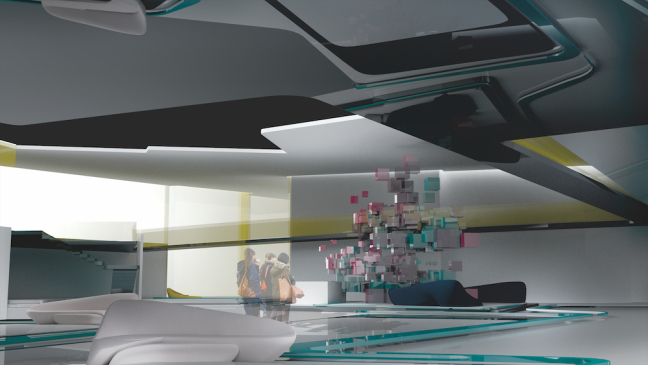
The National Funeral Directors Association reported this year that more and more Americans favor cremation over traditional burials. This year, the cremation rate is projected to be 54.8 percent and the burial rate 39 percent. By 2040, they expect the gap will widen to 78.7 percent cremation and 15.7 percent burial.
“The problem is that from the day of the last interment in a cemetery, standard practice in the industry is that the cemetery has to be maintained as is 200 years forward,” Cagley said.
Americans typically expect a grassy area when they think of a cemetery – but that requires water bills that can skyrocket to thousands of dollars a month. And with increasing numbers of droughts and growing effects of climate change, Cagley says this practice is not sustainable.
“If we assume that many people will be cremated, then what does the interior of a columbarium look like? And what does the landscape look like so it’s attractive enough for a family to bury their loved one?” Cagley said.
The assignment: Design a non-denominational, multi-functional structure in an 80,000-square-foot space in an existing mortuary. The space needs to feel dignified and spiritual while also serving as a space to celebrate the life of the person who died.
“Today’s generations want celebrations of life, not mourning,” Cagley said. “And that’s a challenge. They need to create a space where both live and dead people feel comfortable together. The living can be out of place in a mausoleum, and the dead can be out of place in a home. We need to design an emotional experience outward.”
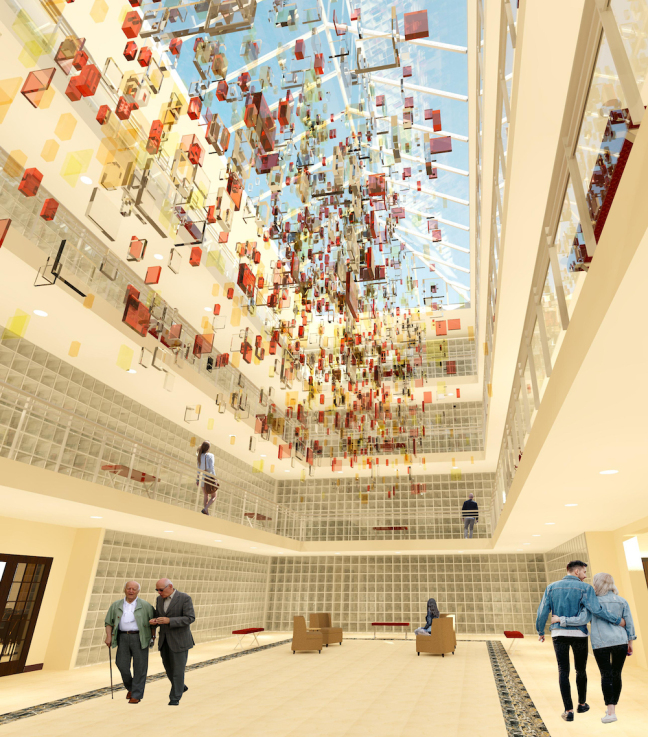
Designing for funerals of the future
Ahmed Elsherif, graduate student in interior design from Egypt, designed that kind of space by blending boundaries. His building grew from a conversation he had with Cagley about the purpose of visitations, a practice with which he was unfamiliar.
Cagley explained it this way: “A visitation is like hello to the deceased; a funeral is like goodbye.”
Elsherif’s proposal incorporates this philosophy, creating an interactive space where people can gather in “the space in between the living world and the person who has died.”
“It is not just a spatial configuration, but a behavioral one as well,” Elsherif said.
Taylor Johnson, graduate student in interior design from Mason City, was inspired by the High Line in New York City, a space she frequented while living there and working in fashion design. The park is a former subway track that was renovated into a long, narrow park, with walking paths, vegetation and seating.
Johnson’s design involves a slowly-inclining park-like space, with burial spots along the way. At the top would be a multipurpose structure for celebrations of life.
“Walking up the incline would be like going through the grieving process, moving from grieving to healing to celebrating that person’s life,” she said. “Too many of these places are designed to make you feel like you want to leave as fast as you can.”
Trevor Kliever, graduate student in interior design from Le Mars, also incorporated that sentiment into his design, creating a space where family and friends can stay and reminisce.
His three-story “library” includes niches on each level to inter cremains. Outside would be a park featuring various burial options, alongside vegetation native to the region.
“Everyone thinks of the concept of yin and yang as separate entities,” he said. “My design takes opposing things and brings them together.”
The students’ work and their research this semester shows people’s widely divergent views about death, funerals and burials.
“Interior design needs to step up to the plate and be forward-thinking,” Cagley said. “The industry is looking at more forward-thinking ideas. Funeral homes were designed for my parents’ generation, and they haven’t been re-examined since. What is being redesigned now is done for my generation — and unfortunately, it’s already two generations behind.”
Complete Article ↪HERE↩!
As a Muslim Mariam lives the ‘five before five’
— and finds meaning and balance as a death doula
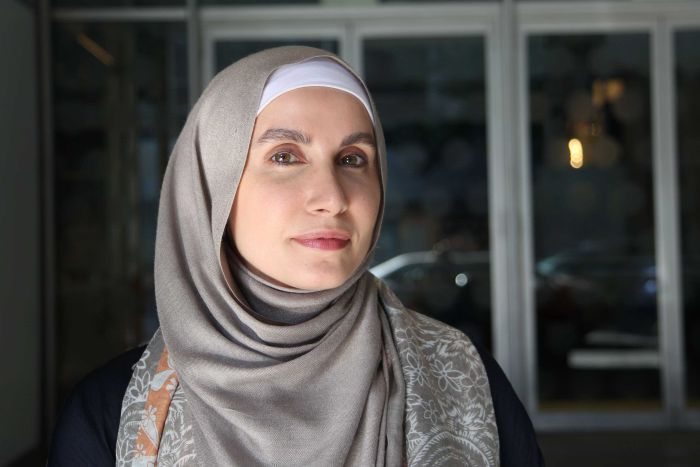
“I collided head on with a truck, the car caught on fire. It was a huge emergency operation,” says Mariam Ardati.
It was one of those car accidents “you think nobody could have survived.”
When she crawled out of the wreckage of her car, Mariam was amazed to see that she didn’t have a single scratch on her.
As a body builder, Mariam had considered herself invincible at the time — at the peak of her fitness.
The close brush with death turned her thoughts to what would have happened to her body under Islamic tradition if she had in fact, died.
“I walked away thinking, ‘where would I have been buried? What would have happened to all my things?'”
After recovering from the trauma of the accident, Mariam says she walked into a funeral parlour and said, “teach me, show me what happens when someone dies”.
The experience prompted a spiritual journey to reconnect with the Sunni Muslim faith she had grown up with.
“I was largely self-centred up until that accident happened,” she told RN’s Soul Search, “and it helped me find purpose and meaning.”
For the last 15 years she has helped other people in the Muslim community through the transition from life into death — as a doula.
Mariam supports the dying and their families in the lead up to death, then leads the ritual care for the body of the deceased.
Anyone can take part in death care
Mariam says women have always performed the final rites for other women.
She wants people to know that there is a range of jobs that family members can do to assist after their loved one has passed away.
Supporting the head, washing the body and brushing the hair are all meaningful ways to care for the deceased.
Mariam describes how she bathes a body an odd number of times, starting with three.
“The first wash is done with soapy water. The second is with clean fresh water. And the third is water that’s poured over the body that’s been infused with camphor.”
Then family members will wrap their loved one in a death shroud that has been perfumed with incense.
“This is afforded to every Muslim that passes away,” she says.
Mariam recalls a woman she worked with who didn’t think she could enter the room where her mother’s body was undergoing the ritual washing.
“She stood at the door of the mortuary and said, ‘I don’t think I can do this, this is just too much for me’.”
Mariam reassured her that she could just watch.
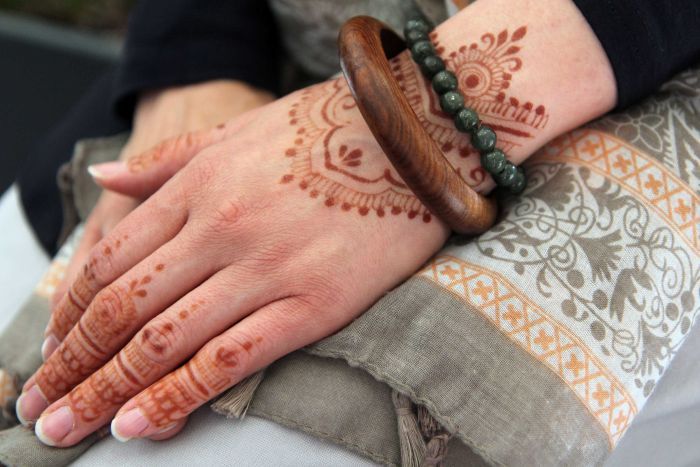
The woman saw the water running, saw Mariam stroking her mum’s hair and talking to her, offering prayers.
By the end of the whole process, the woman had taken over.
“I took a step back and watched her — with a lot of tears and a lot of emotion — go through each ritual in its entirety.”
Mariam says seeing a daughter perform these last rites for her mother “as she’s working through her emotions and coming to terms with her grief is such a powerful thing to witness”.
She recalls many women who say, “I’m so grateful for the fact that I was able to honour my mother in that way,” or “I was able to hold my sister one last time”.
The ‘very human touch’ of burial
Muslim burial rituals have a “very human touch”, says Professor Mohamad Abdalla, referring to the practice of men going down into a grave to lower a body in with their hands, sans coffin.
Mohamad is the director of the Centre for Islamic Thought and Education at the University of South Australia.
He explains that the body is positioned with the head facing Mecca, the traditional direction of prayer.
“With the soil of the grave they make a small pillow to lay his or her head,” Mohamad says.
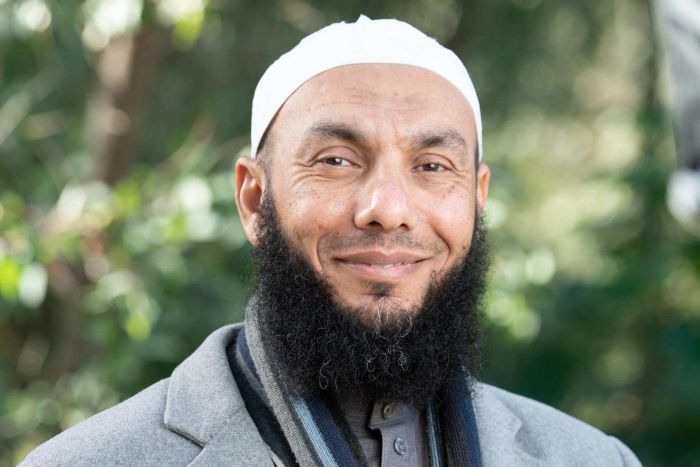
Three quarters of the way up the grave, small edges are carved out to hold several planks of wood.
“The soil is poured over the planks of wood, not touching the body of the deceased, essentially leaving about half a metre … for the circulation of air for natural decomposition.”
Muslim death ritual requires the body be buried as quickly as possible, which can be difficult in the event of a sudden death.
“It’s an honour to bury the deceased within 24 hours,” Mariam says.
She’s referring to the belief that after death, the soul ascends and is given “the glad tidings of heaven”.
When the two are reunited in burial, the soul shares that news with the body, remaining connected throughout the process.
Organ donation and autopsies can complicate the ritual and throw timing off.
“We do exercise our rights to object to an invasive post-mortem, as do other faiths and communities,” Mariam explains.
“We believe that process is an undignified act.”
However, there are alternatives for Muslims, for instance in the case of an unexplained or suspicious death, explains Mohamad.
“In the classical Islamic civilisation, autopsy was undertaken to understand the human body and blood circulation.”
Beyond autopsy, medical procedures after death are technically allowed, because preservation of life is one of the most important objectives of Islamic law, Mohamad says.
He explains that as long as the donor or their family consents voluntarily, organs are not sold, and the organs are healthy, it is a highly virtuous act.
“But the minority viewpoint says a person has no right to dispose of their body as they wish, because it is a trust from God,” he says.
Much of Mariam’s energy is directed to increasing death literacy in the community — helping people become accustomed to the idea of dying.
She encourages the same open approach at home with her own children, in a “mother-daughter bonding exercise”.
“I have cut my own [death] shroud, and I had my daughter by my side with the measuring tape saying, ‘No mum, that’s too short, we need to make it longer this way’.”
‘Five before five’
Mariam sees her job as an opportunity to serve God through caring for other people.
“When you’re living the life of a Muslim, you’re living between two states,” she explains.
One of those refers to “fearing retribution or the accountability of your sins”, and the other is “believing in the hope and mercy of God”
Mariam says she looks for the balance between the two.
It’s a sense of purpose that leads to an understanding that “your actions have consequences, and that you’re part of a larger social context”.
A Muslim is encouraged “to take advantage of what’s known as the five before five,” she explains.
“Your health before sickness, your life before you’re overcome with death, your free time before you become busy, your youth before your old age and your wealth before you become poor.”
Mariam says Muslims’ relationship with God is “underpinned by the understanding that God is the provider of infinite love, compassion and mercy”.
But for a person to earn that favour, she or he must live a life that’s conducive to those values.
In death, Mariam sees our final transition as a deeply communal responsibility, one that she is humbled to be part of.
She says she’s glad her own encounter with a near-fatal accident showed her that she wasn’t invincible.
Rather, it gave her a sense of purpose and meaning.
“I didn’t find that in the world of the living — I found it in the world of the dead.”
Complete Article ↪HERE↩!

